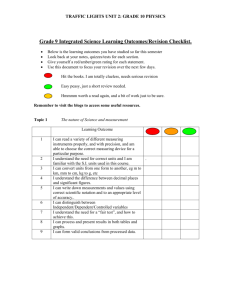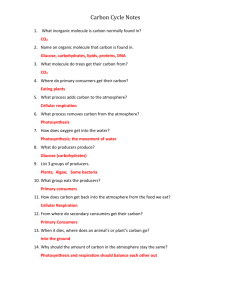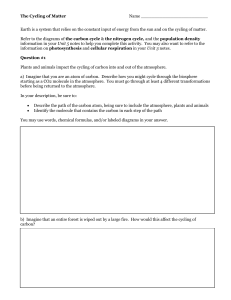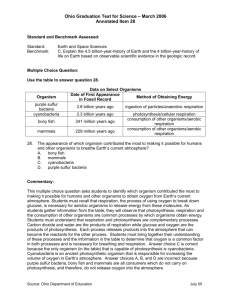Oxygen Basic information
advertisement
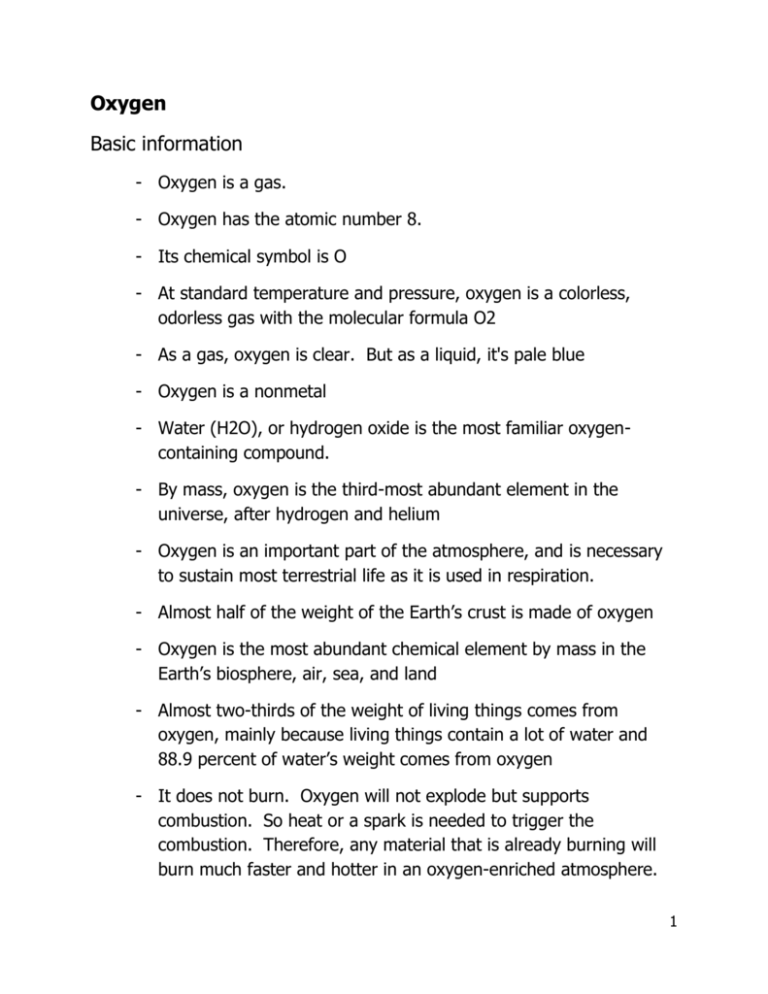
Oxygen Basic information - Oxygen is a gas. - Oxygen has the atomic number 8. - Its chemical symbol is O - At standard temperature and pressure, oxygen is a colorless, odorless gas with the molecular formula O2 - As a gas, oxygen is clear. But as a liquid, it's pale blue - Oxygen is a nonmetal - Water (H2O), or hydrogen oxide is the most familiar oxygencontaining compound. - By mass, oxygen is the third-most abundant element in the universe, after hydrogen and helium - Oxygen is an important part of the atmosphere, and is necessary to sustain most terrestrial life as it is used in respiration. - Almost half of the weight of the Earth’s crust is made of oxygen - Oxygen is the most abundant chemical element by mass in the Earth’s biosphere, air, sea, and land - Almost two-thirds of the weight of living things comes from oxygen, mainly because living things contain a lot of water and 88.9 percent of water’s weight comes from oxygen - It does not burn. Oxygen will not explode but supports combustion. So heat or a spark is needed to trigger the combustion. Therefore, any material that is already burning will burn much faster and hotter in an oxygen-enriched atmosphere. 1 Oxygen production - Oxygen (O2) is unstable in our planet’s atmosphere and must be constantly replenished by photosynthesis in green plants. Without life, our atmosphere would contain almost no O2. - Photosynthesis releases oxygen into the atmosphere, while respiration and decay remove it from the atmosphere. - Elemental oxygen is produced by cyanobacteria, algae and plants and is used in cellular respiration for all complex life - According to some estimates, green algae and cyanobacteria in marine environments provide about 70% of the free oxygen produced on Earth and the rest is produced by terrestrial plants - Green algae and cyanobacteria in marine environments provide about 70% of the free oxygen produced on Earth through photosynthesis and the rest is produced by the terrestrial plants. - Cyanobacteria, which are organisms that “breathe” using photosynthesis, take in carbon dioxide and exhale oxygen, just like modern plants. - Concentrated oxygen will allow combustion to proceed rapidly and energetically - The World’s oceans carry dissolved oxygen that supports life. The polar oceans, being coolest, hold more dissolved oxygen and therefore sustain vast amounts of aquatic life. - Molecular dioxygen, O2, is essential for cellular respiration in all aerobic organisms. - Oxygen is also present in many organic compounds: carbohydrates, fats, fatty acids, amino acids, proteins. 2 Medical - Uptake of O2 from the air is the essential purpose of respiration, so oxygen supplementation is used in medicine. - Treatment not only increases oxygen levels in the patient's blood, but also has the secondary effect of decreasing resistance to blood flow in many types of diseased lungs, easing workload on the heart. - Oxygen therapy is used to treat emphysema, pneumonia, some heart disorders (congestive heart failure), some disorders that cause increased pulmonary artery pressure, COPD and any disease that impairs the body's ability to take up and use gaseous oxygen. - You might need oxygen therapy all of the time or just part of the time. A doctor's prescription is required for supplemental oxygen. - For people who do not get enough oxygen naturally, supplements of oxygen can have several benefits. Oxygen therapy can: Improve sleep and mood Increase mental alertness and stamina Allow a person's body to carry out normal functions Prevent heart failure in people with severe lung disease 3 Toxicity - Too little oxygen is problematic. So is too much. Oxygen toxicity is too much oxygen for too long a period. Breathing 80 percent oxygen for more than 12 hours irritates the respiratory tract and can eventually cause deadly fluid build-up, or edema. - Symptoms of toxicity are seen in the eyes, central nervous system, muscular, respiratory. Eyes: visual field loss, near sightedness, Cataract formation, bleeding, fibrosis. Central Nervous System: Seizures Muscular: twitching Respiratory: jerky breathing, irritation, coughing, pain, SOB, acute respiratory distress system, tracheobronchitis 4 Safety - There are important safety factors to keep in mind when using oxygen. Oxygen is a safe gas and is non-flammable, however, it supports combustion. Materials burn more readily in an oxygenenriched environment. - Avoid open flames in the presence of oxygen use (e.g. matches, cigarette lighters, candles, and burning tobacco). Insist that people who wish to smoke step outside your home to protect your lungs and your home. - Oxygen canisters should be kept at least 5-10 feet away from gas stoves, lighted fireplaces, woodstoves, candles or other sources of open flames. - Do not use electric razors while using oxygen. (These are a possible source of sparks.) - Do not use oil, grease, or petroleum-based products on the equipment. Do not use it near you while you use oxygen. These materials are highly flammable and will burn readily with the presence of oxygen. Avoid petroleum-based lotions or creams, like Vaseline, on your face or upper chest. Check the ingredients of such products before purchase. If a skin moisturizer is needed, consider using cocoa butter, aloe vera or other similar products. For lubrication or rehydration of dry nasal passages, use waterbased products, such as K-Y Jelly. Your pharmacist or care provider can suggest these. - Post signs in every room where oxygen is in use. Make sure that absolutely NO SMOKING occurs in the home or in the car when oxygen is in use. 5 - Secure an oxygen cylinder to a solidly fixed object to avoid creating a missile out of the tank. This might happen if it was accidentally knocked over and gas was allowed to escape. - Use caution with oxygen tubing so you do not trip over it or become entangled in furniture. - Be familiar with the equipment and the safety checks established by the medical equipment provider. Keep their contact telephone numbers, and the numbers for other emergency services, posted near a phone. Do not try to repair broken equipment on your own. Request this service from the oxygen provider. - Make sure smoke detectors in the home are working. Have fresh batteries installed. Perform monthly checks. Have a fire extinguisher available in the home as well. (Use type ABC.) Create and practice an escape and rescue plan in the event of a fire. - Notify the local fire department, gas and electric companies and telephone company when home oxygen therapy is started. Request a "priority service listing.” This is for those times when there is a power or telephone failure or repairs are needed on any utility. - Caution must also be used around other sources of heat, such as electric or gas heaters and/or stoves—at least 6 feet is a recommended distance between oxygen and other heat sources. - It is important to store cylinders safely—cylinders should be upright and secure, in an approved cart or device for storage. - Remember when not in use, oxygen supply valves should be turned off. - Always follow the instructions of your oxygen supply company regarding safe usage. 6 - Never use a Portable Oxygen Concentrator when the apparatus itself is in the trunk of your car. - Start the car before turning on the unit or charging it - Do not leave the device in an automobile but take the unit with you - If the unit has been in a cold environment, allow it to warm up before use - Game controllers should not be used with oxygen; the new systems that vibrate and have other functions have caused issues with patients on oxygen - Never use more than 50 feet of oxygen tubing. This can dilute the concentration of oxygen that the patient is receiving - IF you must cook while using oxygen, make sure the tubing will not touch the gas flame or electric burning - Clean the oxygen system clean and dust free - Stay 6 feet away from toys with electric motors, electric baseboards or space heaters, wood stoves, fireplaces, electric blankets, hairdryers and electric toothbrushes - Keep away from the stove top and oven - Watch out for splattering grease, which can catch fire - Cooking with microwave is ok - Keep liquids that may catch fire away from oxygen. This includes cleaning products that contain oil, grease, alcohol or other liquids that are flammable or can burn. 7

